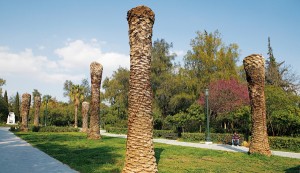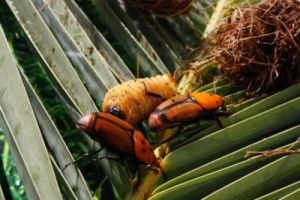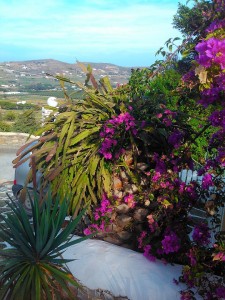
Following the destruction of the Red Palm Weevil – the bug responsible for destroying palm trees throughout the Mediterranean basin – there is an increasing number of unsightly palm stumps in gardens and towns. While one option is to cut these dead trunks, dig them out and get rid of them all together, another option would be to use them as a base to support new plant life, especially if the palm used to be a focal point* in the garden.
 Rynchophorus ferrugineus, or Red Palm Weevil, the culprit.
Rynchophorus ferrugineus, or Red Palm Weevil, the culprit.
 Climbers like Bougainvillea (Bougainvilla glabra, picured), Honeysucle (Lonicera caprifolium), Wisteria (Wisteria floribunda and sinensis) or Star Jasmine (Thachelospermum jasminoides) can be planted close to the base of the stump and shoots trained to hug around the stump making it into an amazing display of flowers.
Climbers like Bougainvillea (Bougainvilla glabra, picured), Honeysucle (Lonicera caprifolium), Wisteria (Wisteria floribunda and sinensis) or Star Jasmine (Thachelospermum jasminoides) can be planted close to the base of the stump and shoots trained to hug around the stump making it into an amazing display of flowers.
 The top part of the palm tree can be dig out to make a “planter”. Chainsaw usually comes handy, its not an easy operation, but doable. The hole than can be filled with good garden earth and succulents** or epiphyte*** plants can be placed.
The top part of the palm tree can be dig out to make a “planter”. Chainsaw usually comes handy, its not an easy operation, but doable. The hole than can be filled with good garden earth and succulents** or epiphyte*** plants can be placed.
 From a practical point of view, if the stump is too tall plant succulents. They don’t need watering even in the summer. Choose from those that usually used as a ground cover, so they hang down nicely on the sides as they grow, and can be enjoyed from not just above the tree but walking underneath. Pigsface (Artenia cordifolia or Μπούζι καρδοφύλλο), Carpobrutus species ( Μπούζι) or Lamphrantus (see on picture we planted a month ago in Holiday Sun Hotel) can be a good choice. This is how you plant a succulent from cuttings. In a years time the shoots will grow and hang down nicely from the palm trunk
From a practical point of view, if the stump is too tall plant succulents. They don’t need watering even in the summer. Choose from those that usually used as a ground cover, so they hang down nicely on the sides as they grow, and can be enjoyed from not just above the tree but walking underneath. Pigsface (Artenia cordifolia or Μπούζι καρδοφύλλο), Carpobrutus species ( Μπούζι) or Lamphrantus (see on picture we planted a month ago in Holiday Sun Hotel) can be a good choice. This is how you plant a succulent from cuttings. In a years time the shoots will grow and hang down nicely from the palm trunk
 If your tree trunk happen to be shorter, so the plants can be seen at your level, you can still go with succulents like Aloe species, Crassulas and Cotyledons. Or you can choose a previously mentioned epiphyte like Hylocereus (on the photo climbing up the trunk see also photo 3. in a private garden in Parikia, Paros) but don’t forget that these plants need regular summer watering. (Low palm trunks can be easily connected to an existing watering system)
If your tree trunk happen to be shorter, so the plants can be seen at your level, you can still go with succulents like Aloe species, Crassulas and Cotyledons. Or you can choose a previously mentioned epiphyte like Hylocereus (on the photo climbing up the trunk see also photo 3. in a private garden in Parikia, Paros) but don’t forget that these plants need regular summer watering. (Low palm trunks can be easily connected to an existing watering system)
Whatever is your choice you should remember that the palm stump that you have given a new life won’t live forever. After 6-8 years you will be up for a new project because most possibly the trunk will rot by then and the structure collapse, but until then, you will have quite a spectacle in your garden!
*Focal point: is every good garden design has got at least one or multiple focal points. They can be showy plants, built structures, statues etc. these focal points catch your attention first and draw your eye and move it through the landscape.
**succulents are are plants having some parts that are more than normally thickened and fleshy, usually to retain water in arid climates or soil conditions.
***An epiphyte is a plant that grows non-parasitically upon another plant (such as a tree), and derives its moisture and nutrients from the air, rain, and sometimes from debris accumulating around it instead of the structure it is fastened to.
Here’s some more pictures to make your palm tree glorious again!
[inpost_gallery thumb_width=”200″ thumb_height=”200″ post_id=”672″ thumb_margin_left=”0″ thumb_margin_bottom=”0″ thumb_border_radius=”2″ thumb_shadow=”0 1px 4px rgba(0, 0, 0, 0.2)” js_play_delay=”3000″ id=”” random=”0″ group=”0″ border=”” type=”yoxview” show_in_popup=”0″ album_cover=”” album_cover_width=”200″ album_cover_height=”200″ popup_width=”800″ popup_max_height=”600″ popup_title=”Gallery” sc_id=”sc1420130237207″]

